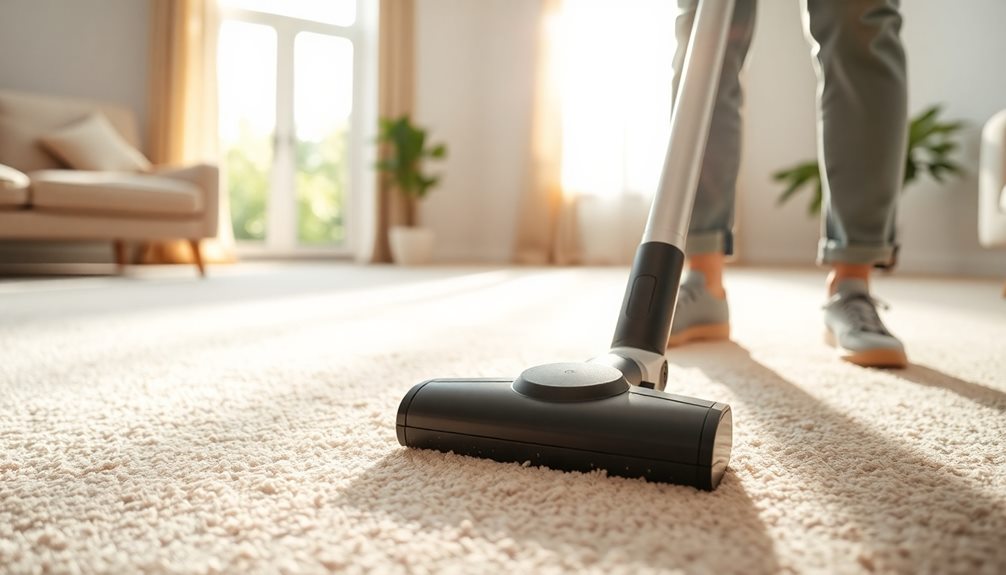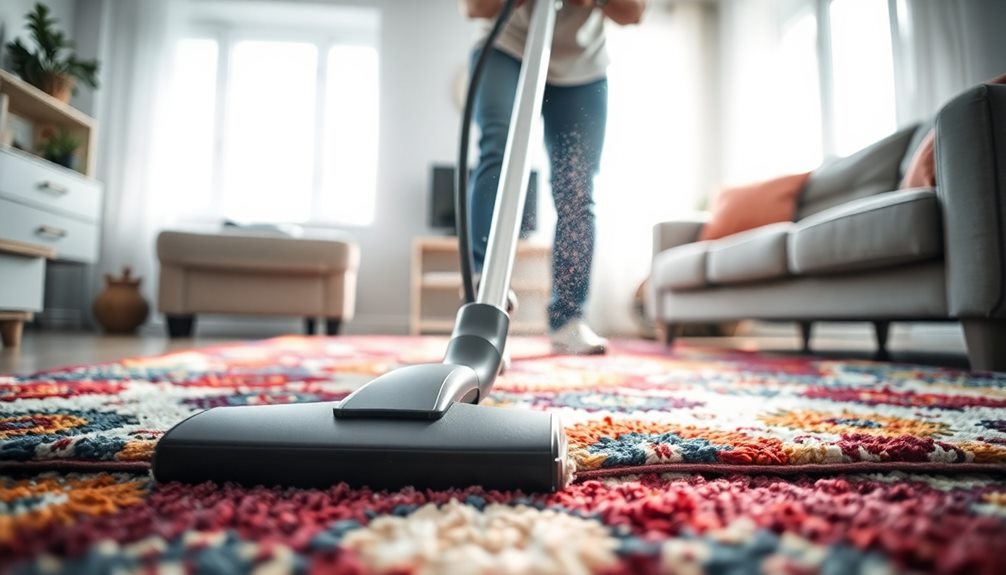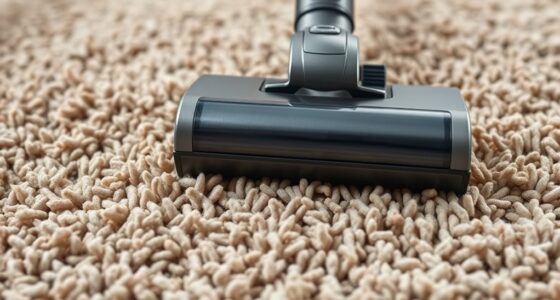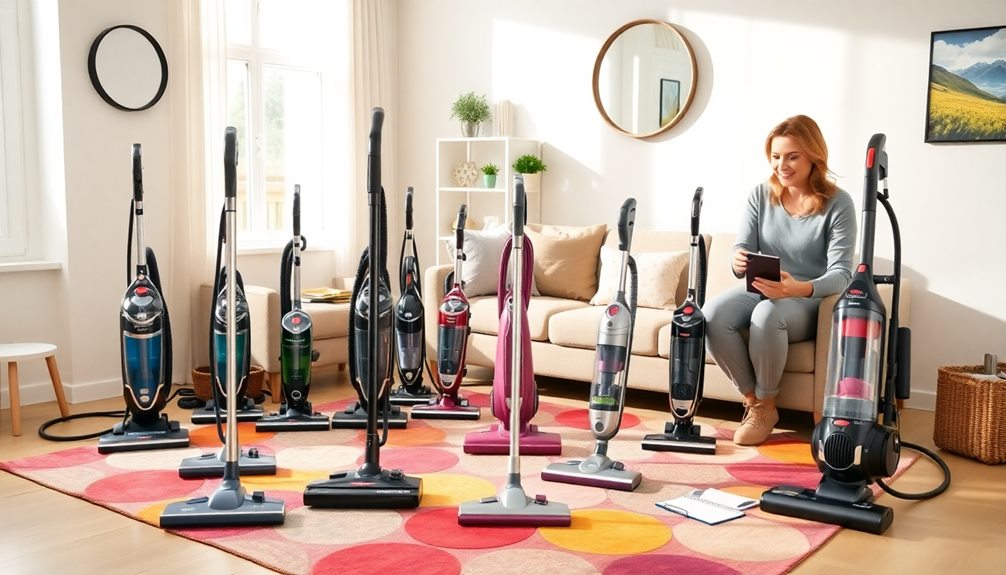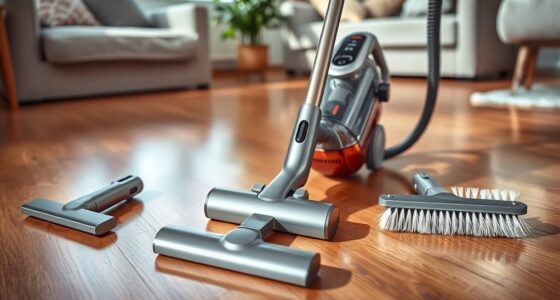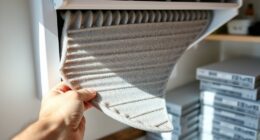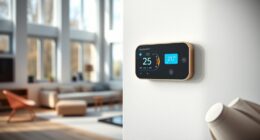To use a vacuum cleaner effectively, start by clearing the area of furniture and obstacles. Work from the farthest corner backward to avoid stepping on cleaned areas. Dust surfaces before vacuuming to prevent debris from falling on the floor. Use slow strokes, especially in high-traffic zones, and overlap your passes for thorough coverage. Keep an eye on the dust bin and empty it when it's 50-75% full to maintain suction. Regular maintenance, like cleaning filters and checking brush rolls, guarantees peak performance. For tips on selecting the right vacuum for your needs, just stick around and see what else you can discover!
Key Takeaways
- Clear the area of furniture and obstacles for unobstructed movement before vacuuming.
- Start vacuuming from the farthest corner and work backward to avoid stepping on cleaned areas.
- Use slow, deliberate strokes and overlap passes, focusing on high-traffic areas for effective cleaning.
- Regularly check the dust bin or vacuum bag and empty it when 50-75% full to maintain suction.
- Utilize attachments like crevice tools and upholstery brushes for specialized cleaning tasks.
Key Steps for Efficient Vacuuming

To achieve efficient vacuuming, there are several key steps you should follow. First, clear the area of furniture and obstacles. This guarantees unobstructed movement and maximizes your coverage, making your cleaning routine more effective.
Start vacuuming from the farthest corner of the room and work your way backward. This way, you won't walk over areas you've already cleaned, and you'll capture any dust that may fall while you work.
Before you begin vacuuming, dust surfaces to prevent loose particles from dropping onto the floor. This simple step enhances your overall efficiency and helps keep your environment clean and healthy.
As you vacuum, use slow, deliberate strokes, especially in high-traffic areas where dirt tends to build up.
Don't forget to regularly check and empty the vacuum bag or dust bin when it's 50-75% full. This maintenance step is essential for maintaining peak suction power, guaranteeing your vacuum cleaner performs at its best.
Effective Vacuuming Techniques
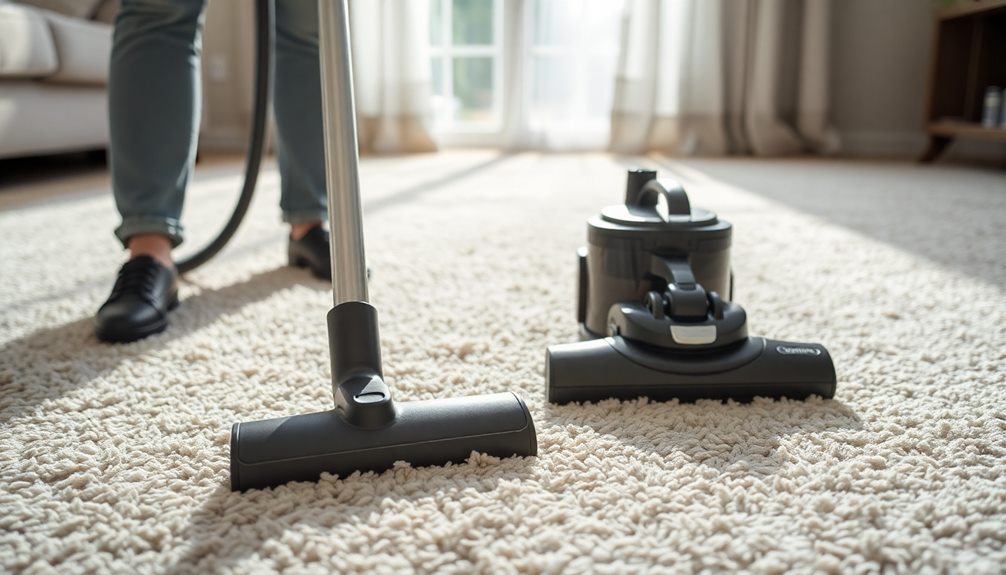
To get the most out of your vacuuming, focus on using slow and deliberate strokes, which can boost your cleaning efficiency greatly.
Choosing the right vacuum can also enhance your cleaning routine, especially models designed for superior dust and allergen elimination like the Best Vacuums for Dust Removal in 2024.
Don't overlook high-traffic areas; they need more attention to prevent dirt buildup.
Proper Vacuuming Strokes
When vacuuming, starting at the farthest corner of the room and working your way backward is key to guaranteeing every spot gets cleaned without stepping on freshly vacuumed areas. By doing this, you create a systematic approach that maximizes efficiency and effectiveness.
Use slow and deliberate strokes, overlapping each pass slightly. This technique helps in maximizing dirt pickup and guarantees thorough cleaning of all surfaces.
Adjust your vacuum height setting based on the type of flooring you're cleaning; lower it for carpets and raise it for hard floors to optimize suction and prevent damage.
Don't forget to utilize attachments for specific tasks. Crevice tools are perfect for corners, while upholstery brushes work wonders on furniture.
These specialized tools enhance your cleaning efficiency and make it easier to reach difficult areas.
Focus on High-Traffic Areas
High-traffic areas like doorways and living rooms accumulate dirt and dust quickly, so it's essential to prioritize vacuuming these spots in your routine. Aim to vacuum these areas at least twice a week to minimize buildup from frequent use.
Start with the most affected zones, as they collect the most debris and can greatly impact your home's overall cleanliness.
When tackling high-traffic areas, remember to vacuum slowly. This method allows your vacuum to effectively lift embedded dirt and dust particles from carpets and upholstery.
Adjust your vacuum's height setting according to the type of flooring to guarantee peak suction and cleaning efficiency. If you're working on carpets, a lower setting might be necessary, while hard surfaces may require a higher one.
Also, regularly check and clean your vacuum's brush roll. Tangled hair and debris can hinder your vacuum's performance, especially in heavily used areas.
Maintenance and Care

To keep your vacuum cleaner running smoothly, you need to stay on top of maintenance tasks.
Regularly empty the dust bin, clean the filters, and check the brush roll for any tangles.
These simple steps help guarantee your vacuum performs at its best and lasts longer.
Regular Filter Cleaning
Regular filter cleaning is crucial for keeping your vacuum cleaner running efficiently, as clogged or dirty filters can reduce suction power by up to 50%. To maintain peak suction and airflow, you should regularly clean or replace your vacuum's filters every 1-3 months. This simple maintenance task greatly improves your vacuum's overall cleaning efficiency.
Additionally, using specialized vacuums for pet hair, such as those from Bissell and Shark, can further enhance your cleaning routine by guaranteeing effective pet hair removal and reducing allergens in your home. Best vacuums for pet hair
If your vacuum has washable filters, rinse them under cold water until the water runs clear. Make sure to allow the filters to air dry completely before reinserting them into the vacuum. This guarantees that you're not putting damp filters back into your machine, which can lead to mold growth and unpleasant odors.
For bagged vacuums, replace the bag when it's two-thirds full. Doing so helps prevent loss of suction and protects the motor from potential damage.
Always consult the manufacturer's guidelines for specific recommendations on filter maintenance, as these can vary from model to model.
Emptying Dust Bin
Maintaining your vacuum cleaner goes beyond just filter care; emptying the dust bin is equally important for peak performance. After each use, make it a habit to empty the dust bin to maintain ideal suction power. A full container can greatly hinder performance and lead to dirt buildup, which could contribute to a healthier lifestyle by promoting cleanliness and hygiene in your home.
Before you start emptying, verify the vacuum is unplugged to avoid any accidental starts or injuries. Detach the dust bin from the vacuum, and dispose of the contents in a trash bag. This minimizes dust escape and prevents allergens from spreading in your home.
Additionally, regularly check the dust bin for debris buildup. This simple step helps maintain your vacuum's efficiency and prolongs its lifespan.
Periodically wash the dust bin with warm, soapy water, making sure it's completely dry before reattaching it to the vacuum. Moisture-related issues can arise if you skip this step, so always prioritize drying.
Brush Roll Maintenance
Inspecting the brush roll frequently is vital for keeping your vacuum cleaner running at its best. Over time, hair, string, and debris can accumulate, hindering performance and suction efficiency.
To maintain ideal function, follow these straightforward steps:
- Regularly check for tangled materials.
- Use scissors or a knife to cut away any obstructions.
- Clean the brush roll with a damp cloth to remove dust and dirt.
If you notice signs of wear or damage, it's important to replace the brush roll. A worn brush can greatly reduce your vacuum's cleaning power.
Additionally, make hygiene a priority by disinfecting the brush roll and surrounding areas. Simply use rubbing alcohol on a cotton swab to eliminate bacteria.
Troubleshooting Common Issues

When you encounter issues with your vacuum cleaner, knowing how to troubleshoot can save you time and frustration. If you notice a loss of suction, start by checking for clogged filters or a full dustbin.
Make sure to empty the dustbin regularly to keep your vacuum cleaner operating efficiently.
Unusual noises can also signal a problem; debris caught in the brush roll may be the culprit. Inspect the brush roll and clear any tangled hair or objects to restore functionality.
If your vacuum is overheating, it's likely due to overuse. Allow it to cool down before using it again to prevent damage.
Additionally, if your vacuum's battery isn't charging, check the charging station for cleanliness and inspect the connections for any faults. Sometimes, a simple cleaning can resolve the issue.
Always refer to your user manual for specific error codes and troubleshooting steps tailored to your vacuum model.
This can help you identify and fix problems more efficiently, ensuring your vacuum cleaner remains in top condition for all your cleaning needs.
Choosing the Right Vacuum
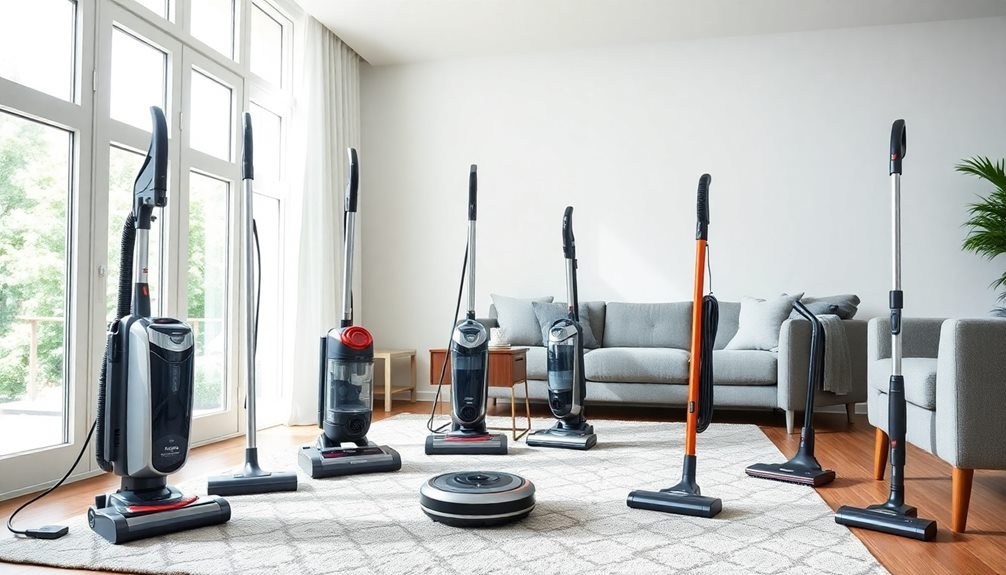
Choosing the right vacuum cleaner is vital for keeping your home clean and comfortable. Your choice should align with your specific cleaning needs and the types of surfaces you have. Here are some key points to take into account:
- Assess your primary cleaning needs: carpets, hardwood floors, or a mix.
- Evaluate different types: upright, canister, robot, cordless, or wet/dry.
- Look for features that enhance usability: lightweight designs, bagless options, and HEPA filters.
As you're choosing the right vacuum cleaner, think about the functionality that suits your lifestyle. For example, if you have pets or allergies, a model with a HEPA filter might be vital for improving air quality.
Also, reflect on how easy it's to maneuver; a lightweight vacuum can make cleaning less of a chore.
Don't forget to research warranties and customer support options. A solid warranty can provide peace of mind, indicating the manufacturer's confidence in their product.
Environmental Considerations
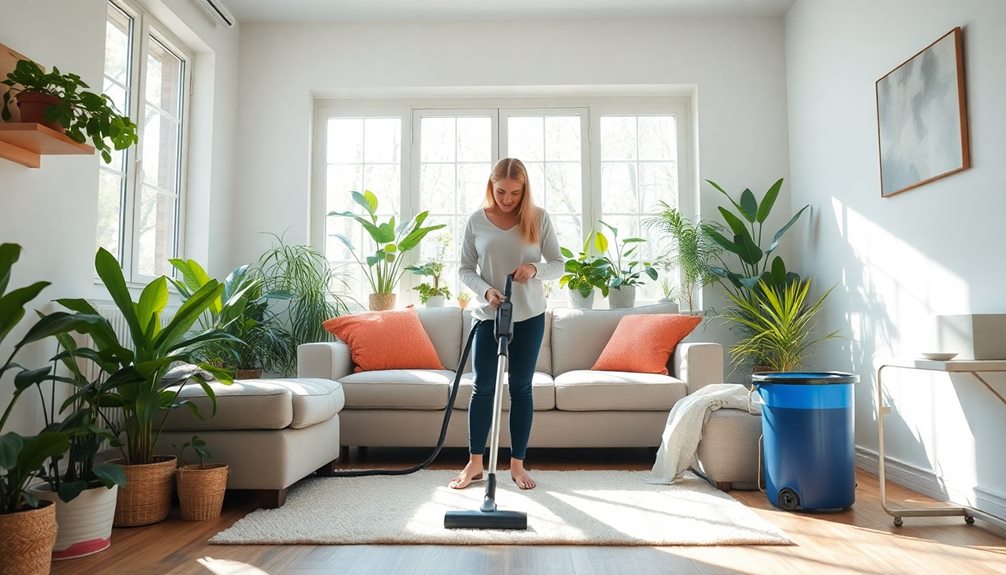
Once you've selected the right vacuum cleaner for your home, it's important to reflect on its environmental impact. By understanding how your choice affects the planet, you can make more sustainable decisions.
Here's a quick comparison of key environmental features to evaluate:
| Feature | Benefits | Importance |
|---|---|---|
| Energy Efficiency | Uses up to 30% less energy | Reduces electricity consumption |
| Recyclable Materials | Made from materials that can be recycled | Promotes sustainability |
| HEPA Filter | Traps allergens and pollutants | Improves indoor air quality |
| Sustainable Manufacturing | Less energy used in production | Lowers emissions |
Opt for Energy Star-rated vacuums that consume less electricity while still delivering performance. Many models are crafted from recyclable materials, ensuring they don't just end up in a landfill. Additionally, using a vacuum with a HEPA filter enhances your indoor air quality, creating a healthier environment for your family. Finally, don't forget to recycle your old vacuum cleaner, supporting circular economy initiatives and minimizing waste. Every small step you take contributes to a cleaner, more sustainable future.
Frequently Asked Questions
How Does a Vacuum Cleaner Work Step by Step?
A vacuum cleaner works by creating suction with its motor, drawing in air and dirt. The rotating brush agitates carpet fibers, while filters trap fine particles, keeping your space clean and fresh. Regular maintenance enhances performance.
How Do You Properly Use a Vacuum?
Using a vacuum's like tending a garden; you must prepare the soil. Check the dust bin, adjust your approach for different surfaces, and move deliberately, ensuring every corner flourishes with cleanliness. Your efforts cultivate a fresh home.
How to Assemble a Vacuum Cleaner Step by Step?
To assemble your vacuum cleaner, unpack all components. Connect the hose, attach the handle, and add any necessary tools. Finally, plug it in and verify everything's secure before you start using it.
How to Use Vacuum Cleaner for Carpet?
To effectively use a vacuum cleaner on carpet, adjust the height setting, clear debris, and vacuum in slow, overlapping rows. Focus on high-traffic areas, and remember to clean the brush roll afterward for peak performance.
Conclusion
By following these steps, you'll have your space spotless in no time. Remember, using the right techniques and maintaining your vacuum can make all the difference. Don't let a little dirt get the best of you—stay on top of vacuuming to keep your home welcoming and clean. With the right approach, you'll sweep away the hassle and enjoy a fresh environment that feels like home sweet home!
